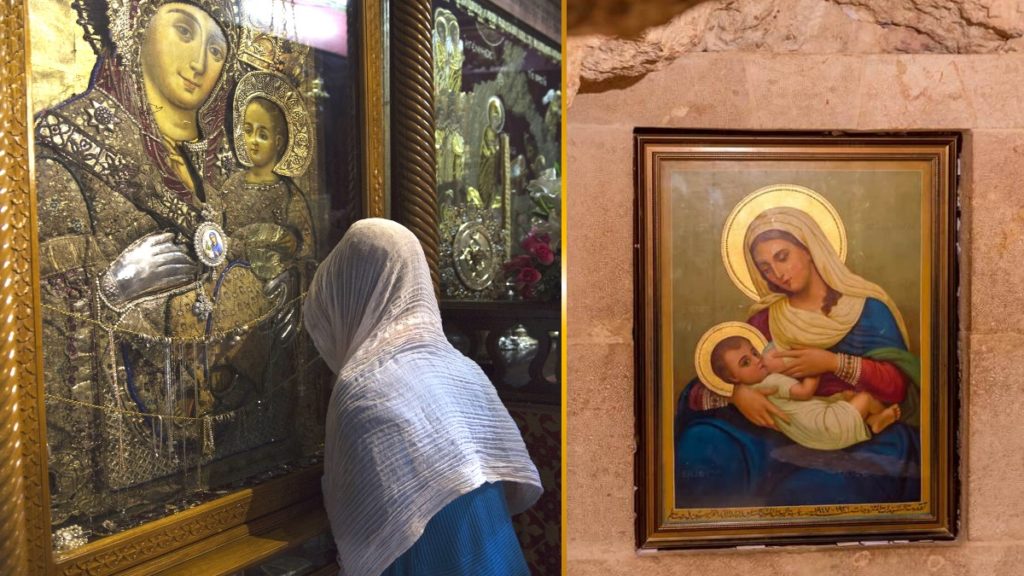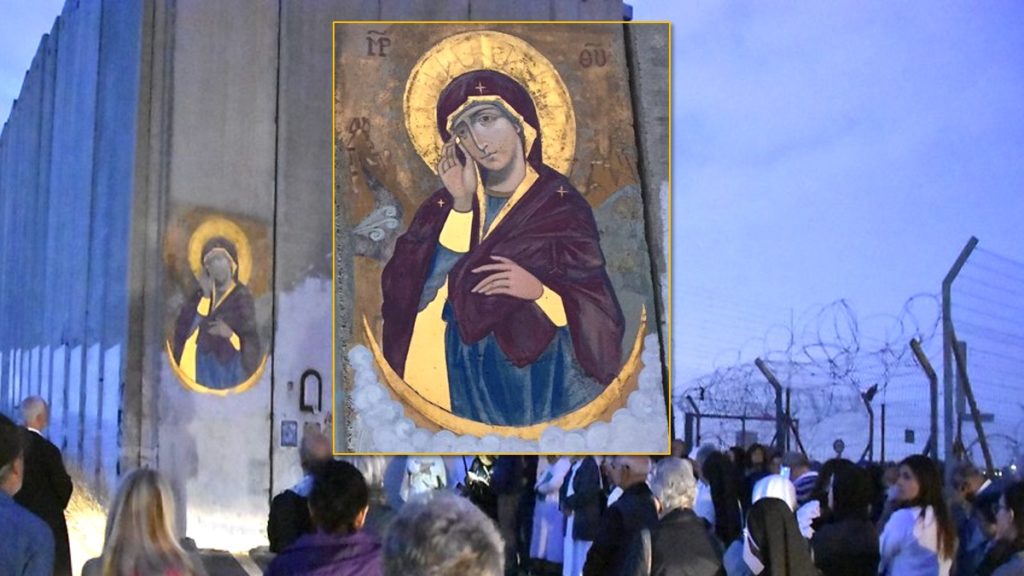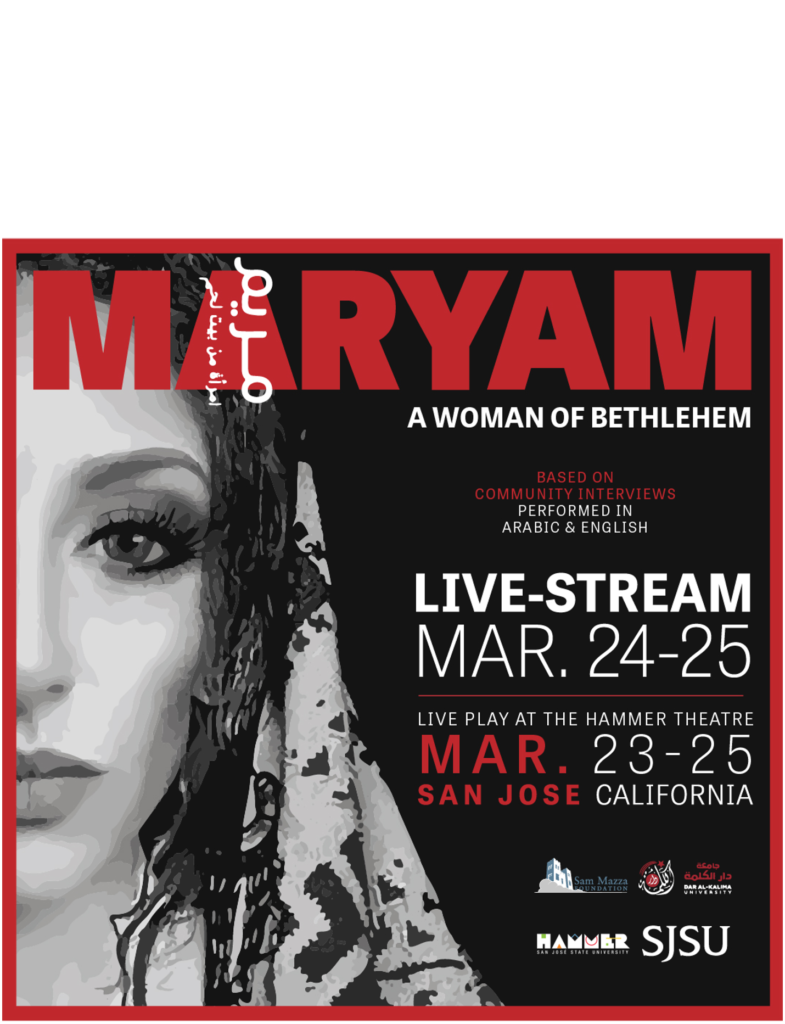As the masculine energies of the Iron Age/5th Sun wane, we see the rise of Divine Feminine energy, resistance and resilience being the hallmarks ushering in the Golden Age/6th Sun. Victoria Rue’s latest play, Maryam: A Woman of Bethlehem, embodies the Divine Feminine in brave and uplifting ways that inform, entertain, and inspire. Two Palestinian actresses from Bethlehem play 22 characters of different ages, Christians and Muslims and undeclared, living in the city where it is said Mary/Maryam gave birth to Jesus, who is known as Issa in Islam. Bethlehem today continues to draw believers from around the world. The play is FREE in San Jose, CA, March 23-25 thanks to generous sponsors, but seats are limited and need to be reserved.
What is Divine Feminine energy?
According to the ancient Toltec civilization which thrived in Mesoamerica millennia ago, humanity has experienced a succession of eras, known as Suns, each of which lasted approximately 6,000 years and have their own characteristics. The 5th Sun, known as the Sun of injustice, ended on May 26, 2021, with the birth of the 6th Sun, the Sun of rising consciousness and the Divine Feminine. While it will take centuries to fully embrace the 6th Sun, early signs of its appearance are already being felt.
All we know is the 5th Sun: we were born into it and it has been the driving force in culture for all recorded time. This Sun of Injustice was a time of masculine energy with endless wars and conquests. The era was ruled by the left brain, materialism, inequality, the powerful oppressing the powerless, victim/perpetrator mentality, and the law of karma. Invasions and occupations, such as Russia invading Ukraine and Israel occupying Palestine, are vestiges of a dying era that is ending. The 6th Sun is not about conquest or oppression.
In contrast to the 5th Sun, the Toltec described the 6th Sun as a time of feminine energy, harmony, and unity. The era is ruled by the right brain, spirituality, equality, alignment with nature, and unconditional love.
The 6th Sun is a time that welcomes:
– The power of our subconscious to create and shape our own destinies for self-healing and the highest good of the collective.
– The forces of nature, the invisible planes, and other dimensions, recovering the multi-dimensionality of who we really are.
– Higher consciousness to recover our connection with life force, the magnetic field of the Earth, a more empathic connection with others, and the Divine Source.
In order to leave the 5th Sun and join the 6th Sun, we have to see things differently, envision different possibilities for life on Earth. Often we’re required to wake up, either on our own or through an inciting incident or close call, in order to recognize that our long-held beliefs are no longer helping us and are, in fact, holding us back. The only way to truly change is to shine a light on, and bring to consciousness, the deepest, darkest levels of ourselves. When we begin to understand our own subconscious, we are able to move in the direction of our highest destiny and the greatest good for all.
It can help to have examples of the Divine Feminine that we can turn to for inspiration and support, and fortunately the story of Mary/Maryam, and the play Maryam: A Woman of Bethlehem, provide both.
Who was Mary/Maryam?
There’s no question that Christianity and Islam are patriarchal religions, yet one female icon in both religions was able to gain unprecedented standing and respect to the point that she continues to inspire and provide sustenance the world over. Mary, as she is known in the Christian world, or Maryam in the Islamic world, is both an ancestor of mythic proportions and a spirit who speaks to and with millions around the world every day. As a bridge-builder, she is the meeting place between Islam and Christianity.
Most people in the West know the Christian story of Mary who was impregnated by a mystical spirit and gave birth to a holy son Jesus in a manger in Bethlehem. But they may not know the Islamic story of Maryam, who gave birth to a holy son Issa/Jesus after having been impregnated by a mystical spirit. Mary/Maryam birthed and raised a divine/prophetic son who went on to become a man whose prophecies changed the world. Millions still revere her memory and try to live up to the high ideals she represents. Mary/Maryam’s role in history cannot be underestimated.
While Mary/Maryam represents the Divine Feminine, Maryam’s story is different from Mary’s. To get an idea of how important Maryam is, she is the only woman mentioned in the Qur’an and has an entire surah (chapter) named after her. Maryam is an unwed pregnant woman who comes to Bethlehem not because of a census count but to flee the scorn and humiliation she was sure to face in her village as a single mother. As her story unfolds, we come to see Maryam as filled with faith, self-reliant, and courageous as she fought against insurmountable odds to bring her holy son into the world.
Because she radiates Divine Feminine energy, Mary/Maryam is loved and admired for her capacity to forgive, her aid to the suffering, and her unconditional love. She represents an ideal to which we can all aspire: to forgive, to help those in need, and to embody love with ourselves and the world.
Part of why Mary/Maryam is venerated is that she suffered mightily in her life. Like any woman of her time, she was trapped in a patriarchal system which regarded women as chattel. In addition, the Romans ruled Palestine with a brutal occupying force causing untold misery, suffering, and death. Despite (or because) of these circumstances, Mary/Maryam embodies the Divine Feminine at work. Her resistance to, and resilience in the face of, violent oppression shows how the Divine Feminine shines through even the darkest of times.
Mary/Maryam was a strong woman who challenged the status quo and tried to change the society in which she lived. Her heroism and fortitude were passed on to her son. Maryam is as honored in Islamic culture as Mary is in Christian culture. And no place is Maryam more beloved than in Bethlehem, Palestine, where her presence dominates the city.
Mary/Maryam in the modern world
What Mary/Maryam means in the contemporary world depends on who you ask. Some Christian branches do not pay much attention to Mary (Protestant) while others venerate her through prayer, songs, paintings, icons, and statues (Catholic, Eastern Orthodox, Anglican, Lutheran). Maryam holds a singularly exalted place in Islam, and she is considered by the Qur’an to have been the greatest woman in the history of humankind.
Mary/Maryam is very much present in modern Bethlehem. Her image dominates the holy sites and symbology throughout the city. Perhaps most importantly, millions pray to Mary/Maryam daily, invoking her name and her presence to support them in their lives. People who have experienced miracles or healings through Mary leave tokens of their gratitude to her at her icon at the Church of the Nativity in Bethlehem, where she is known as the Palestinian Mary for having a round, beatific face. Both Christians and Muslims light candles near her image, as they do at her image in the city’s Milk Grotto.

We may think that things have changed over 2,000 years, but if Mary/Maryam returned to Bethlehem today, she would once again find a brutal occupying force and not much change in terms of patriarchy. As a Palestinian woman today, she would face both external oppression from violent political forces, and internal oppression from men wielding power over women in families and society.
That tension touches every Palestinian woman, and is expressed in “Our Lady Who Brings Down Walls,” a mural painted on the cement Separation wall that was erected by Israelis. Here, rather than a smiling Mary holding her infant son, we see a pregnant Mary touching her head as if in intense pain. Her arm and cloak are open as a place of refuge and safety, and she is seen as an icon of hope that the wall will someday come down. “Our Lady Who Brings Down Walls” is another example of the Divine Feminine energy meeting oppression with resistance and resilience.

We can learn something – be awakened – by understanding that centuries of oppression can be met by resistance and resilience with Divine Feminine energy. The time of victims and perpetrators, oppressors and oppressed, is ending. Mary/Maryam’s message of the Divine Feminine is more relevant now than ever. It is from this perspective that Mary/Maryam holds extraordinary meaning in our world today as a woman on an inspired mission fighting against enormous odds. It is this understanding that informs “Maryam: A Woman of Bethlehem.”
“Maryam: A Woman of Bethlehem”
As we look for signs of the rise of the Divine Feminine energy in our lives today, a striking example will be on stage in San Jose, CA, from March 23-25. “Maryam: A Woman of Bethlehem” is a Divine Feminine wake-up call delivered in a most inspiring and thought-provoking way.
Playwright/director Victoria Rue asked the question “Who is Mary/Maryam in twenty-first century Bethlehem?” She conducted dozens of interviews in Bethlehem with Christians and Muslims and shaped them into the play “Maryam: A Woman of Bethlehem.”
To bring the play to life, two very special women from the other side of the world are coming to the USA for the very first time to bring the play to life. Dalia Shakhtour and Rufaida Farraj portray twenty-two characters, from 12–87 years of age, Christian and Muslim Palestinians, whose stories help us appreciate Mary/Maryam, Palestine, and Palestinian women’s lives today. Having toured Palestine to glowing reviews, these intrepid actors are taking the trip of a lifetime (having never been in America) to perform the play in San Jose.
These two young women’s journeys to the USA to bring Mary/Maryam to us are living embodiments of the Divine Feminine at work.
Why see the play live when you could stream it?
Imagine stepping off an airplane into a land you’ve never been to before, where people speak a foreign language and have different customs and laws. Your job once you arrive is to stand open and vulnerable on a brightly-lit stage in a darkened room, speaking to strangers you can’t see, hoping you do justice to the story you have come to tell. This is the definition of bravery and deserves to be honored and supported. Just as Mary/Maryam’s story invokes compassion and veneration, so does the heroism shown by Dalia and Rufaida who are facing tremendous challenges to bring Mary/Maryam’s story to life in America.
Theatre is a live space where magic happens. In a theatre audience you are not just a receptive vessel – you participate in the theatrical experience. The actors are feet away from you; you feel their energy and experience their emotions. You witness courage in its rawest form – the courage to tell a story while being defenseless and exposed, hiding nothing. Stories have the power to touch us deeply, wake us up from slumber, and empower us to take action. You can leave a theatre a changed person.
If you want to honor Mary/Maryam and the Divine Feminine, consider attending one of the performances which are FREE thanks to generous sponsors listed in the Resources below. A full house each night is the best way we can thank Dalia and Rufaida for their courage, Victoria for writing such an important play, and all the people who have helped make “Maryam: A Woman of Bethlehem” possible. You can also join the livestream March 24th and 25th, but nothing takes the place of live theatre.
Plays like this are signs that the 6th Sun is here, ready to shine light on inequality and suffering, and sweep away intolerance and persecution. Please join us in supporting this exceptional and inspiring work.
Resources
Watch a short trailer for “Maryam: A Woman of Bethlehem.”
Learn more about the genesis of the play in this 2019 interview with Victoria Rue and Hind Abu Shkhadim.
Meet the team behind “Maryam: A Woman of Bethlehem” here.
Learn more about Maryam in Islam at Mary in Islam and Maryam/Wikipedia.
Learn more about Mary in Christianity at Mary, mother of Jesus and Theotokos.
Learn more about the rise of the Divine Feminine at Venus Conjunct Mars-Feminine Energy Rises, and 6th Sun Meaning for Humanity and You.
Learn more about the Toltec civilization, the 6th Sun, and the rise of the feminine by reading Sixth Sun: Meaning for Humanity & You, Meditation Script for May 2022 Full Moon, and watching Birth of the 6th Sun.
Learn more about healing and consciousness at Inner Treasure Hunt. If you liked this post, you can subscribe to the Inner Treasure Hunt newsletter to stay informed about new posts, programs, and events. #innertreasurehunt
Please share this post with your friends! Just click below.



